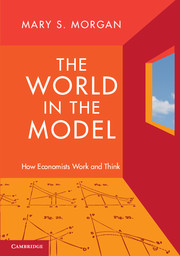Book contents
- Frontmatter
- Contents
- Figures, Tables, and Boxes
- Preface
- 1 Modelling as a Method of Enquiry
- 2 Model-Making: New Recipes, Ingredients, and Integration
- 3 Imagining and Imaging: Creating a New Model World
- 4 Character Making: Ideal Types, Idealization, and the Art of Caricature
- 5 Metaphors and Analogies: Choosing the World of the Model
- 6 Questions and Stories: Capturing the Heart of Matters
- 7 Model Experiments?
- 8 Simulation: Bringing a Microscope into Economics
- 9 Model Situations, Typical Cases, and Exemplary Narratives
- 10 From the World in the Model to the Model in the World
- Index
- Plate Section
- References
6 - Questions and Stories: Capturing the Heart of Matters
Capturing the Heart of Matters
Published online by Cambridge University Press: 05 November 2012
- Frontmatter
- Contents
- Figures, Tables, and Boxes
- Preface
- 1 Modelling as a Method of Enquiry
- 2 Model-Making: New Recipes, Ingredients, and Integration
- 3 Imagining and Imaging: Creating a New Model World
- 4 Character Making: Ideal Types, Idealization, and the Art of Caricature
- 5 Metaphors and Analogies: Choosing the World of the Model
- 6 Questions and Stories: Capturing the Heart of Matters
- 7 Model Experiments?
- 8 Simulation: Bringing a Microscope into Economics
- 9 Model Situations, Typical Cases, and Exemplary Narratives
- 10 From the World in the Model to the Model in the World
- Index
- Plate Section
- References
Summary
Introduction
Scientific models are not passive objects but form sophisticated instruments of enquiry. Models are objects to enquire into and to enquire with: economists enquire into the world of the economic model, and use them to enquire with into the economic world that the model represents. What kind of reasoning turns these pieces of mathematics or little diagrams into a means of enquiry? And how is it that these enquiries lead economists to feel that they have captured something of the heart of the matter, either of their theories or of the economic world, in their models?
The question: ‘How do economists use models?’ is, in one sense, easy to answer: they ask questions with them and tell stories! Or more exactly: they ask questions, use the resources of the model to demonstrate something, and tell stories in the process. At first sight, it is difficult to see exactly why questions are needed, or what the stories do. How does asking questions of models and telling stories with them enable them to function as epistemic instruments that economists might learn from using and that might capture the heart of anything? Let me begin with an example that shows how stories can shape the reasoning resources of models before going on to show how and why economists working with models typically ask questions and tell similar kinds of stories when they reason with them.
- Type
- Chapter
- Information
- The World in the ModelHow Economists Work and Think, pp. 217 - 255Publisher: Cambridge University PressPrint publication year: 2012



